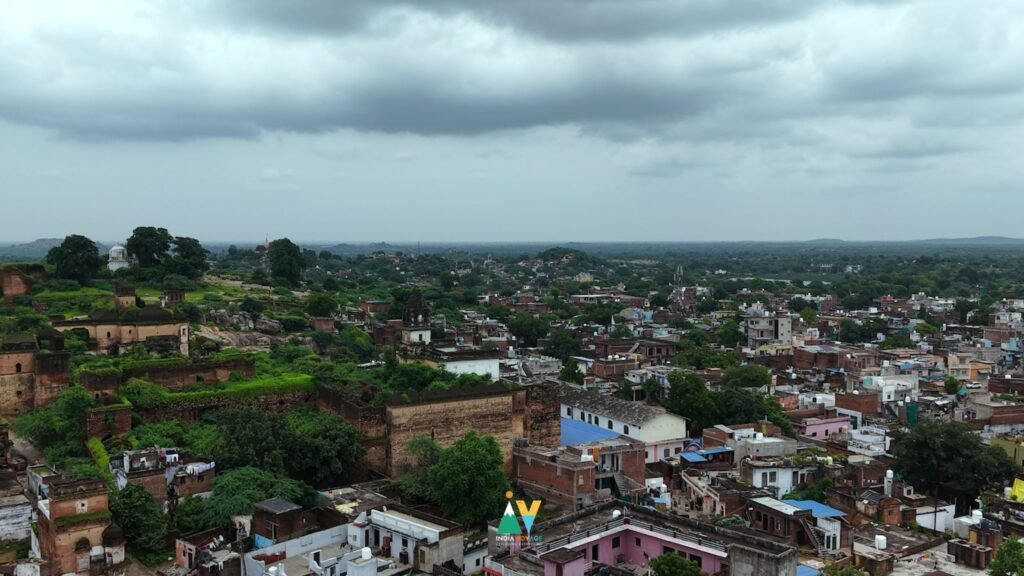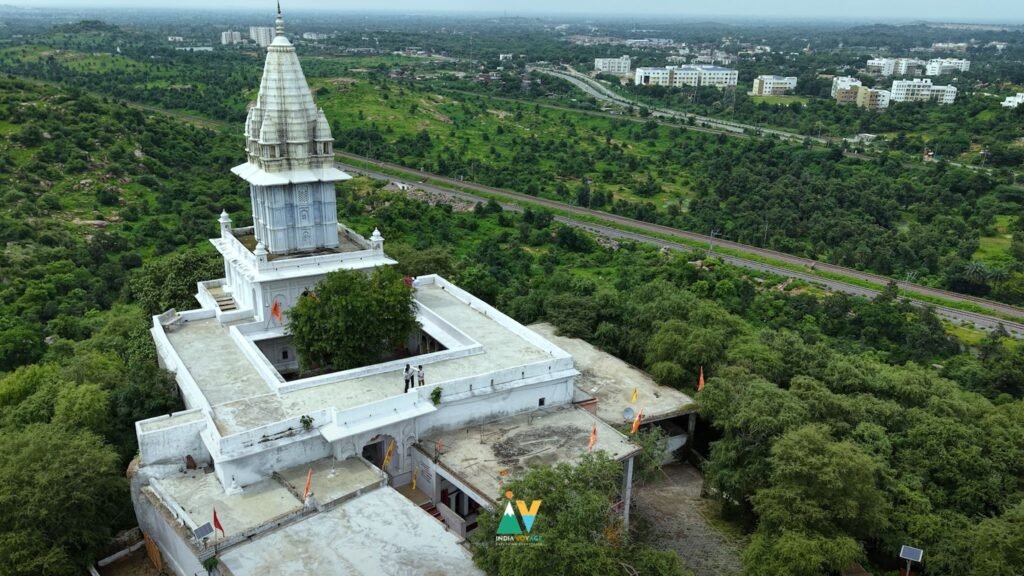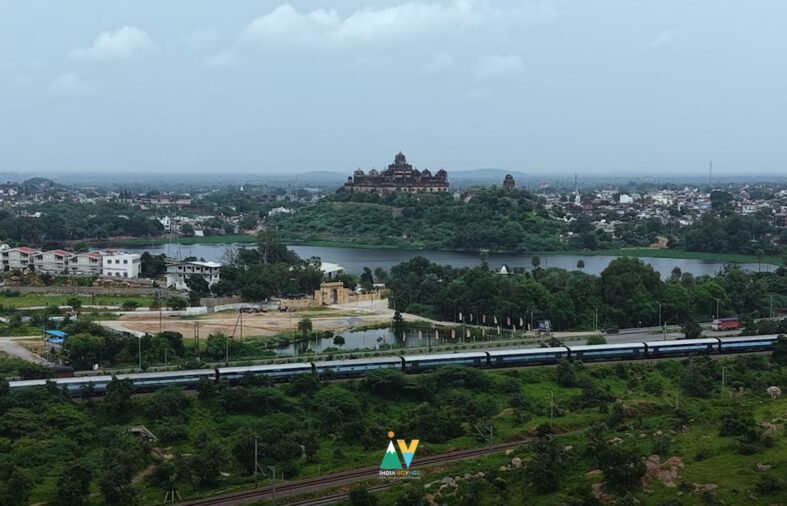Nestled in the northern part of Madhya Pradesh, India, Datia is a captivating town that often flies under the radar for travelers seeking the state’s more famous destinations like Gwalior or Orchha. Yet, this district headquarters holds a treasure trove of historical landmarks, cultural traditions, and religious sites that reflect its deep-rooted heritage in the Bundelkhand region. From majestic palaces echoing tales of Rajput valor to serene temples drawing pilgrims from across the country, Datia offers a unique glimpse into India’s multifaceted past. At the heart of its spiritual allure lies the revered Pitambara Peeth, a site of immense devotion and mystical energy. In this article, we’ll explore Datia’s rich tapestry, with a special focus on this iconic temple complex.

A Glimpse into Datia’s Historical Legacy
Datia’s story begins in ancient times, with references in epic texts like the Mahabharata, where it’s linked to the Chedi Kingdom under King Dantavakra. Archaeological finds, including Ashokan inscriptions nearby, hint at its importance during the Mauryan era around the 3rd century BCE. However, the town’s modern identity took shape in the medieval period under the Bundela Rajputs.
Established as a princely state in the early 17th century by Rao Bhagwan Rao, a descendant of the Orchha rulers, Datia flourished as a center of power and culture. The Bundelas, known for their alliances with the Mughals, built fortifications and palaces that blended Rajput grandeur with Islamic influences. During the British colonial era, Datia became part of the Central India Agency through the 1802 Treaty of Bassein, maintaining its semi-autonomous status until India’s independence in 1947. Post-independence, it integrated into Madhya Pradesh in 1956, evolving from a royal domain into a vibrant district known for agriculture, handlooms, and tourism.
Today, with a population exceeding 800,000 in the district, Datia thrives on its historical sites while embracing modern development. Its economy revolves around grain trading, cotton, and small-scale industries, but it’s the town’s heritage that truly captivates visitors.
Architectural Wonders: From Palaces to Forts
One of Datia’s crowning jewels is the Datia Palace, also called the Bir Singh Palace or Jahangir Mahal. Constructed in 1614 by Raja Bir Singh Deo of Orchha, this seven-story edifice stands as a testament to innovative architecture, built entirely from stone and bricks without using wood or iron. Its design features intricate balconies, domes, and chhatris (canopies), showcasing a harmonious fusion of Mughal and Rajput styles. Interestingly, the palace was meant to host Emperor Jahangir but remained unoccupied by royalty, serving instead as an administrative hub. Its influence even extended to colonial designs, inspiring elements in New Delhi’s architecture by Sir Edwin Lutyens.
Beyond the palace, Datia boasts remnants of forts and gateways that once guarded its borders. The town’s layout, with its narrow lanes and old havelis (mansions), evokes a bygone era of royal splendor and strategic defense.
The Spiritual Epicenter: Pitambara Peeth – A Deep Dive into Devotion and Mysticism
No visit to Datia is complete without exploring Pitambara Peeth, a sprawling temple complex that serves as a beacon of spiritual power and one of India’s prominent Shakti Peeths. Dedicated primarily to Goddess Baglamukhi, also revered as Pitambara Devi, this site embodies the fierce yet protective energy of the divine feminine. As one of the ten Mahavidyas (great wisdom goddesses) in Hinduism, Baglamukhi is believed to paralyze enemies, grant victory in disputes, and bestow wisdom and eloquence. Devotees flock here seeking protection from adversities, success in legal battles, and spiritual enlightenment, making it a hub for tantric practices and rituals.

Historical Roots and Establishment
The origins of Pitambara Peeth trace back to ancient legends, with some traditions linking the site to the Mahabharata era through its association with ascetic practices on what was once a cremation ground. However, the modern complex was founded in the 1920s by Pujya Shri Golokvasi Swami Ji Maharaj, a revered saint who transformed the area into a sacred ashram and temple precinct. Swami Ji, known for his deep sadhana (spiritual discipline), established the peeth to honor Pitambara Devi, drawing on the site’s inherent mystical vibrations. Over the decades, it has grown into a multifaceted spiritual center, incorporating an ashram for seekers and facilities for pilgrims.
Contrary to some claims of it being over 700 years old, the peeth’s current form is a 20th-century creation, though its spiritual significance predates this by centuries through oral traditions and local folklore. The site’s evolution reflects a blend of ancient tantric heritage and modern devotional practices, making it a living bridge between eras.
Architectural Splendor and Key Shrines
Spanning a vast area, Pitambara Peeth is not just a single temple but a complex of shrines, each with its own aura. The main sanctum houses the idol of Goddess Baglamukhi, adorned in yellow (pitambara means “clad in yellow”), symbolizing her radiant power. The architecture features vibrant murals, intricate carvings, and colorful frescoes that depict mythological scenes, creating an immersive devotional environment.
Adjacent shrines add to the peeth’s allure:
- Dhumavati Temple: Dedicated to another Mahavidya, Goddess Dhumavati, representing the widow aspect of the divine, this shrine is a focal point for those seeking detachment and inner strength.
- Vankhandeshwar Shiva Temple: Believed to date back to the Mahabharata period, this ancient Shiva lingam is said to have been worshipped by sages for millennia, adding a layer of timeless sanctity.
- Other structures include smaller temples for deities like Hanuman and smaller Mahavidyas, along with meditation halls and gardens that promote tranquility.
The overall design emphasizes functionality for large gatherings, with open courtyards for rituals and accommodations for visitors.
Significance and Rituals
Pitambara Peeth holds profound spiritual importance as a Siddha Peeth, where prayers are believed to manifest quickly due to the goddess’s benevolent grace. It’s particularly revered in tantric traditions, where Baglamukhi’s energy is invoked for “stambhan” (paralysis of negativity). Daily aartis (prayer ceremonies) and havans (fire rituals) fill the air with chants and incense, creating a charged atmosphere.
Special rituals include the Baglamukhi Havan, performed to overcome obstacles, and tantric pujas conducted by learned priests. The peeth also hosts educational programs on Vedas and yoga, fostering holistic spiritual growth.
Festivals and Celebrations
The complex comes alive during festivals, drawing massive crowds. Navratri, celebrated twice a year (Chaitra and Sharad), is the highlight, with nine days of elaborate poojas, processions, and cultural performances. During these periods, the temple resonates with devotional songs, dances, and midnight vigils. Other key events include Guru Purnima, honoring Swami Ji, and Diwali, when the peeth is illuminated with lamps symbolizing the triumph of light over darkness.
Pilgrims often participate in community feasts (bhandaras) and charitable activities, emphasizing the peeth’s role in social welfare.
Other Attractions and Cultural Vibes
Beyond Pitambara Peeth, Datia offers Sonagiri, a Jain pilgrimage site with gleaming white temples atop a hill, and the Datia Museum, housing Bundela artifacts like sculptures and coins. The town’s culture is steeped in Bundeli traditions, with folk music, dance forms like Rai, and festivals like Holi celebrated with gusto. Local cuisine features hearty dishes like dal bafla and sweets made from Bundelkhand’s grains.
Planning Your Visit: How to Reach and Tips
Datia is well-connected by road and rail, about 75 km from Gwalior (nearest airport) and 30 km from Jhansi. The best time to visit is October to March, avoiding the summer heat. Stay options range from budget guesthouses to heritage hotels. Respect temple customs: dress modestly, remove footwear, and participate mindfully in rituals.











Leave A Reply